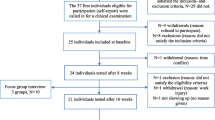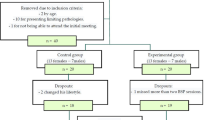Abstract
The aim of this study was to determine whether a multi-dimensional intervention programme was effective in reducing the incidence of low back pain (LBP) and the associated levels of pain and disability in schoolgirl rowers. This non-randomised controlled trial involved an intervention (INT) group consisting of 90 schoolgirl rowers from one school and a control (CTRL) group consisting of 131 participants from three other schools. All participants in the INT group underwent a multi-dimensional programme that consisted of an individualised exercise programme based on an individual musculoskeletal screening (Week 1) and a LBP education session conducted by a physiotherapist (Week 2) and performed an off-water-conditioning programme conducted by a Physical Education teacher. All exercises were undertaken during the season. Primary outcome variables collected at Start-season, Mid-season, End-season and Post-season included the incidence of LBP and related levels of pain and disability. Secondary outcome variables from the bio-psycho-social domain were measured at Start-season and End-season in the INT group only. The INT group had a lower incidence of LBP at Mid-season and End-season and displayed significantly better results than the CTRL group for improvers and non-improvers with respect to the levels of pain and disability. The INT group following the intervention also displayed improved physical fitness levels, sat with significantly less anterior tilt of the pelvis and lumbar kyphosis when in their usual sitting posture and demonstrated positive changes in their behaviour. The multi-dimensional approach to reducing the incidence of LBP, pain and disability in schoolgirl rowers in this study was effective. Several secondary outcome variables measured in the INT group considered to be of importance in LBP significantly improved. These included physical fitness (aerobic conditioning, lower limb and back muscle endurance and sit and reach flexibility) and seated posture (usual and slump sitting).




Similar content being viewed by others
References
Abernethy L, Bleakley C (2007) Strategies to prevent injury in adolescent sport: a systematic review. Br J Sports Med 41:627–638
Achenbach TM (1991) Manual for Child Behaviour Checklist/4–18 and 1991 profile. University of Vermont, Department of Psychiatry, Burlington
Akuthota V, Nadler SF (2004) Core strengthening. Arch Phys Med Rehabil 85:S86–S92
Bahr R, Andersen S, Loken S, Fossan B, Hansen T, Holme I (2004) Low back pain among endurance athletes with and without specific back loading—a cross-sectional survey of cross-country skiers, rowers, orienteerers and nonathletic controls. Spine 29:449–454
Balague F, Troussier B, Salminen JJ (1999) Non-specific low back pain in children and adolescents: risk factors. Eur Spine J 8:429–438
Baranto A, Hellstrom M, Cederlund C, Nyman R, Sward L (2009) Back pain and MRI changes in the thoraco-lumbar spine of top athletes in four different sports: a 15-year follow-up study. Knee Surg Sports Traum Arthosc 17:1125–1134
Baranto A, Hellstrom M, Nyman R, Lundin O, Sward L (2006) Back pain and degenerative abnormalities in the spine of young elite divers: a 5-year follow up magnetic resonance imaging study. Knee Surg Sports Traum Arthosc 14:907–914
Beiring-Sorenson F (1984) Physical measurements as risk indicators for low back trouble over a one year period. Spine 9:106–119
Biddle SJH, Gorely T, Stensel DJ (2004) Health enhancing physical activity and sedentary behaviour in children and adolescence. J Sports Sci 22:679–701
Boland AL, Hosea TM (1991) Rowing and sculling and the older athlete. Clin Sports Med 10:245–256
Cusi MF, Juska-Butel CJG, Arlick D, Argyrous G (2001) Lumbopelvic stability and injury profile in rugby union players. NZ J Sports Med 29:14–18
Dillingham T (1995) Evaluation and management of low back pain: an overview. State Art Rev 9:559–574
Feyer A, Herbison P, Williamson A, de Silva I, Mandryk J, Hendrie L, Hely M (2000) The role of physical and psychological factors in occupational low back pain: a prospective cohort study. Occup Environ Med 57:116–120
Grant S, Corbell K, Amjad A, Wilson J, Aitchison T (1995) A comparison of methods of predicting maximum oxygen uptake. Br J Sports Med 29:147–152
Harringe M, Nordgren JS, Arvidsson I, Werner S (2007) Low back pain in young female gymnasts and the effect of specific segmental muscle control exercises of the lumbar spine: a prospective controlled intervention study. Knee Surg Sports Traum Arthosc 15:1264–1271
Harris J, Tyre C, Wilkinson C (1993) Using the child behaviour checklist in ordinary primary schools. Br J Educ Psychol 63:145–260
Hellstrom M, Jacobsson B, Sward L, Peterson L (1990) Radiologic abnormalities of the thoraco-lumbar spine in athletes. Acta Radiol 31:127–132
Hestbaek L, Leboeuf-Yde C, Kyvik KO, Manniche C (2006) The course of low back pain from adolescence to adulthood: Eight-year follow up of 9,600 twins. Spine 9:106–119
Hickey GJ, Fricker PA, McDonald WA (1997) Injuries to elite rowers over a 10-yr period. Med Sci Sports Exerc 29:1567–1572
Howell D (1984) Musculoskeletal profile and incidence of musculoskeletal injuries in lightweight women rowers. Am J Sports Med 12:278–281
Hudson-Cook N, Tomes-Nicholson D, Breen A (1989) A revised Oswestry disability questionnaire. Manchester
Jackson D (1979) Low back pain in young athletes: evaluation of stress reaction and discogenic problems. Am J Sports Med 7:364–366
Kirkcaldy BD, Shephard RJ, Siefen RG (2002) The relationship between physical activity and self-image and problem behaviour among adolescents. Soc Psychiatry Psychiatr Epidemiol 37:544–550
Lundin O, Hellstrom M, Nilsson I, Sward L (2001) Back pain and radiological changes in the thoraco-lumbar spine of athletes: a long-term follow-up. Scand J Med Sci Sports 11:103–109
Mattila V, Saarni L, Parkkari J, Koivusilta L, Rimpela A (2008) Predictors of low back pain hospitalisation—a prospective follow-up of 57,408 adolescents. Pain 139:209–217
Mills JD, Taunton JE, Mills WA (2005) The effect of a 10-week training regimen on lumbo-pelvic stability and athletic performance in female athletes: a randomized-controlled trial. Phys Ther Sport 6:60–66
Mitchell T, O’Sullivan P, Burnett A, Straker L, Smith A (2008) Regional differences in lumbar spinal posture and the influence on low back pain. BMC Musculoskelet Disord 9:152
Mitchell T, O’Sullivan P, Smith A, Burnett A, Straker L, Thornton J, Rudd C (2008) Biopsychosocial factors are associated with low back pain in female nursing students: a cross-sectional study. Int J Nurs Stud 45:1636–1644
Moffroid M, Reid S, Henry SM, Haugh LD, Ricamoto A (1994) Some endurance measures in persons with chronic low back pain. J Orthop Sports Phys Ther 20:81–87
Nadler SF, Malanga GA, Bartoli LA, Feinberg JH, Prybicien M, Deprince M (2002) Hip muscle imbalance and low back pain in athletes: influence of core strengthening. Med Sci Sport Exerc 34:9–16
O’Sullivan P, Dankaerts W, Burnett AF, Farrell GT, Jefford E, Naylor CS, O’Sullivan KJ (2006) Effect of different upright sitting postures on spinal-pelvic curvature and trunk muscle activation in a pain-free population. Spine 31:707–712
O’Sullivan P, Grahamslaw KM, Kendell M, Lapenskie SC, Moller NE, Richards KV (2002) The effect of different sitting and standing postures on trunk muscle activity in a pain-free population. Spine 27:1238–1244
O’Sullivan P, Mitchell T, Bulich P, Waller R, Holte J (2006) The relationship between posture, lumbar muscle endurance and low back pain in industrial workers. Man Ther 11:264–271
O’Sullivan PB (2004) ‘Clinical Instability’ of the lumbar spine: its pathological basis, diagnosis and conservative management. In: Boyling JD, Jull GA (eds) Grieve’s modern manual therapy of the vertebral column. Churchill-Livingstone, Edinburgh, pp 311–331
Ogon M, Krismer M, Sollner W, Kantner-Rumplmair W, Lampe A (1996) Chronic low back pain measurement with visual analogue scales in different settings. Pain 64:425–428
Paluska SA, Schwenk TL (2000) Physical activity and mental health: current concepts. Sports Med 29:167–180
Perich D, Burnett A, O’Sullivan P (2006) Low back pain and the factors associated with it: Examination of adolescent female rowers. In: XXVIth symposium on biomechanics in sports, University of Salzburg, Salzburg, pp 355-358
Ranson C, Kerslake R, Burnett A, Batt M, Abdi S (2005) Magnetic resonance imaging of the lumbar spine in asymptomatic professional fast bowlers in cricket. J Bone Joint Surg Br 87:1111–1115
Reichborn-Kjennrud T, Stoltenberg C, Tambs K (2002) Back-neck pain and symptoms of anxiety and depression: a population-based twin study. Psychol Med 32:1009–1020
Roy S, De Luca C, Snyder-Mackler L, Emley M, Crenshaw R, Lyons J (1990) Fatigue, recovery and low back pain in varsity rowers. Med Sci Sports Exerc 22:463–469
Stallard M (1999) The challenge of rowers backache. Sports Med Today 1:53–55
Stanton R, Reaburn P, Humphries B (2004) The effect of short-term Swiss ball training on core stability and running economy. J Strength Cond Res 18:522–528
Stevenson J, Weber CL, Smith JT, Dumas GA, Albert WJ (2001) A longitudinal study of the development of low back pain in an industrial population. Spine 26:1370–1377
Sward L, Hellstrom M, Jacobsson B, Peterson L (1990) Back pain and radiologic changes in the thoraco-lumbar spine of athletes. Spine 15:124–129
Symonds T, Burton AK, Tillotson KM, Main CJ (1995) Absence resulting from low back trouble can be reduced by psychosocial intervention at the workplace. Spine 20:2738–2745
Symonds T, Burton AK, Tillotson KM, Main CJ (1996) Do attitudes and beliefs influence work loss due to back trouble? Occup Med 46:25–32
Trafimow J, Schipplein OK, Novak GJ, Andersson GBJ (1993) The effects of quadriceps fatigue on the technique of lifting. Spine 18:364–367
Tse M, McManus A, Masters R (2005) Development and validation of a core endurance intervention program: Implications for performance in college-age rowers. J Strength Cond Res 19:547–552
Acknowledgments
The authors wish to acknowledge Perth College for funding this study, its staff for the assistance in the implementation and all of the rowers who participated. They also thank Tim Mitchell, Alison Thorpe, Liz Pyne, Sarah Wiin, Joao Paulo Caneiro, Linda Gooch, Jenny Woods and Wim Dankaerts for providing the physiotherapist intervention, John Watson for assisting with the data collection and Katherine Cheng for analysing the Child Behaviour Checklists. Thanks also to Lars Ankarberg, Megan Gooding, Rogier Nelis, Frank Offermann and Jannike Persson for their assistance. Finally, we would like to thank Gemma DeKnock, David Milne, Fiona Wilkinson, Keith Reynolds, Gavin Russell, Clare Reeson and Alison Turner who were the rowing co-ordinators from the participating schools.
Author information
Authors and Affiliations
Corresponding author
Rights and permissions
About this article
Cite this article
Perich, D., Burnett, A., O’Sullivan, P. et al. Low back pain in adolescent female rowers: a multi-dimensional intervention study. Knee Surg Sports Traumatol Arthrosc 19, 20–29 (2011). https://doi.org/10.1007/s00167-010-1173-6
Received:
Accepted:
Published:
Issue Date:
DOI: https://doi.org/10.1007/s00167-010-1173-6




